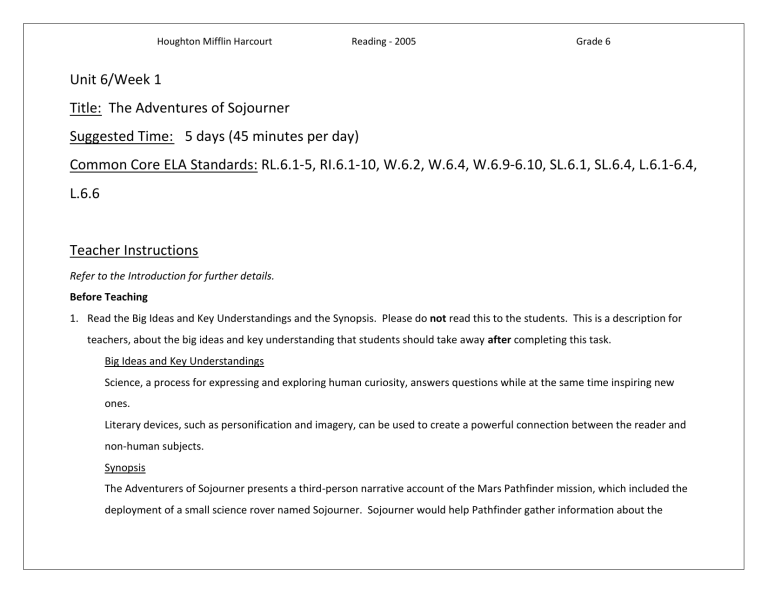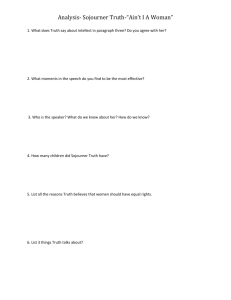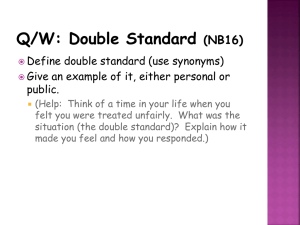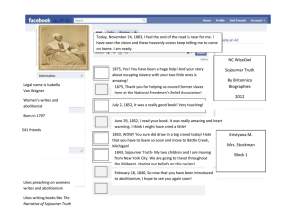
Houghton Mifflin Harcourt Reading - 2005 Grade 6 Unit 6/Week 1 Title: The Adventures of Sojourner Suggested Time: 5 days (45 minutes per day) Common Core ELA Standards: RL.6.1-5, RI.6.1-10, W.6.2, W.6.4, W.6.9-6.10, SL.6.1, SL.6.4, L.6.1-6.4, L.6.6 Teacher Instructions Refer to the Introduction for further details. Before Teaching 1. Read the Big Ideas and Key Understandings and the Synopsis. Please do not read this to the students. This is a description for teachers, about the big ideas and key understanding that students should take away after completing this task. Big Ideas and Key Understandings Science, a process for expressing and exploring human curiosity, answers questions while at the same time inspiring new ones. Literary devices, such as personification and imagery, can be used to create a powerful connection between the reader and non-human subjects. Synopsis The Adventurers of Sojourner presents a third-person narrative account of the Mars Pathfinder mission, which included the deployment of a small science rover named Sojourner. Sojourner would help Pathfinder gather information about the Houghton Mifflin Harcourt Reading - 2005 Grade 6 planet’s surface. Although the Pathfinder mission was scheduled to last one month, the small rover was expected to have only a week’s longevity. Surprisingly Sojourner outlasted Pathfinder, which lose communication with NASA on Sol 83 (the 83rd Martian day of its journey). Throughout the entire exploration, the lander, rover and mission personnel at NASA were able to examine several rock formations on the planet’s surface. The results of these studies surprised mission scientists very much and paved the way for new, similar projects in the future. 2. Read entire main selection text, keeping in mind the Big Ideas and Key Understandings. 3. Re-read the main selection text while noting the stopping points for the Text Dependent Questions and teaching Vocabulary. During Teaching 1. Students read the entire main selection text independently. 2. Teacher reads the main selection text aloud with students following along. (Depending on how complex the text is and the amount of support needed by students, the teacher may choose to reverse the order of steps 1 and 2.) 3. Students and teacher re-read the text while stopping to respond to and discuss the questions and returning to the text. A variety of methods can be used to structure the reading and discussion (i.e.: whole class discussion, think-pair-share, independent written response, group work, etc.) Text Dependent Questions Text Dependent Questions Reread the first seven paragraphs on p. 551. The author switches from an informative writing style to a narrative (story telling) style. Where does this transition start? At what point does it end? What text features help to emphasize the transition? Answers The transition begins in the third paragraph when she questions the reader, then invites him/her to imagine they are present on Mars. The transition to narrative concludes when the author states, “in the Mission Operations room.” All text after that point is in the third person narration, where as the Houghton Mifflin Harcourt Reading - 2005 On p. 551, as the author describes the opening of Pathfinder’s parachute, what comparison does she make? Why does she choose this comparison historically and literally? As Pathfinder makes its final landing on Mars, airbags protect it from violent impact. What image does the author use to help the reader understand this technical procedure? P. 555 Reread page 555. What words does the author use to reveal the feelings of the different mission personnel on Earth after the Pathfinder landing? How does the author explain these differences? Personification is when a non-human subject is given attributes of a living thing. On p 555, which words does the author use to help create the perception of Sojourner as human? Symbiosis describes a relationship in which two people exist together because they depend on each other to satisfy a need or needs. Reread pp. 555-556. Does this word apply to the relationship between Sojourner and the NASA team? Why or why not? Grade 6 text before is conversational in tone. The indented line after the questioning set and the change of font also indicate the shift of style. The author compares the explosions that control the landing process to fireworks on Independence Day. This comparison is relevant because the lander reached the moon on July 4th, American’s Independence Day. The comparison is also made because fireworks are also created by explosions and are generally loud as the Pathfinder must have also been. The author compares the landing spacecraft to a “giant beach ball.” The mission commander is happy as are most of the scientists and engineers. Their dream of landing a craft on Mars was realized. The mission geologist is worried because he is not yet certain that his dreams, the study of actual rocks will come true, because there are not yet images being transmitted from the lander. The pronoun “she” is used to identify the rover. She “gathered herself up to her full 12 inch height” makes her seem childlike—or like Wall-E, which as it turns out was based on Sojourner!). The author also says, “Sojourner got to work” when actually the scientists at NASA controlled it remotely. She also left “imprints” (footprints) in the soil “trailing behind.” Answers may indicate a one-sided relationship with NASA personnel using Sojourner to meet a need or set of needs (i.e. analyzing rock samples and transmitting pictures. Other answers may recognize mutual dependence. Sojourner needing direction and input from NASA, but NASA could not provide that direction or insight without the information Sojourner was sending back to NASA. The author says Houghton Mifflin Harcourt Reading - 2005 Reread p. 556-667, where the author states, “In keeping with the spirit of the mission, thought, everyone agreed to release the photos immediately.” What can we infer about the spirit of the mission from this decision? What other evidence in the text indicates this spirit? How did the hazard avoidance system enable Sojourner to become more independent? What other systems helped her grow up during the course of her travels on Mars? P. 559 Scientists expected Sojourner to function in the harsh Mars climate for 7 days. How long did she actually function? What organizational structure used by the author helps the reader determine this? P. 560 Reread p. 562. The author describes what may have been the last experiences of Sojourner on Mars and the decision of the NASA team to end the mission. What words or phrases reveal the tone of these paragraphs to the reader? What information does the author give to show Sojourner’s legacy, or what she left behind? (p. 562) Grade 6 Sojourner “helped Brian Cooper.” This statement follows a statement that scientists usually hold off on sharing data until they have analyzed it. This departure from normal practice must mean that the spirit of the mission could be said to be openness, curiosity, new frontiers, knowledge… anything that recognizes the importance of sharing the experience. Further evidence shows in the open chat rooms, webcams and access to information from Mars available on the mission website. The hazard avoidance system allowed Sojourner to move around under her own control. She also used a laser location system to find the objects she needed to sample. The actual time Sojourner remained functional at least 74 Sols; it is not possible to determine an actual end date for the rover because the lander ceased functioning before Sojourner. The author organizes the text by marking time in Sols. “On Sol 83” the last full transmission was sent to Earth from Pathfinder. The tone is lonely or sad. The author says that Sojourner “repeatedly asked for command from Earth, but there would have been no reply.” The team “reluctantly” ends the mission and “would still try once a month to pick up a signal.” The author recaps the important learning that occurred thanks to her investigations, and connects her research to future possibilities for research. Houghton Mifflin Harcourt Reading - 2005 Grade 6 Vocabulary STUDENTS FIGURE OUT THE MEANING sufficient context clues are provided in the text TEACHER PROVIDES DEFINITION not enough contextual clues provided in the text KEY WORDS ESSENTIAL TO UNDERSTANDING Bermuda Triangle, p. 560 descent, p. 551 imprints, p. 555 protruding, p. 557 halted, p. 558 WORDS WORTH KNOWING General teaching suggestions are provided in the Introduction tether, p. 551 propulsion, p. 551 array, p. 555 complex, p. 551 detached, p. 551 faint, p. 553 unconventional, p. 553 retracted, p. 554 offending, p. 554 accustomed, p. 554 hazards, p. 556 encrusted, p. 557 avoidance, p. 559 uncontaminated, p. 560 sufficient, p. 561 reluctantly, p. 562 relatively, p. 562 Houghton Mifflin Harcourt Reading - 2005 Grade 6 Culminating Task Re-Read, Think, Discuss, Write Sojourner was a machine; however, throughout the text the author uses language to create particular connections between the reader and the rover. Discuss at least three examples of this language use, and explain the effect this language is intended to have. Answer: Strong answers will include references to personification or images that are evocative of emotion. Example: “It was less a ‘so long’ than a ‘see you later.’” This phrase shows a connection between NASA and the machine that is indicative of familiarity and hope for future relationship. It is intended to show a bond between them. Of course several examples were discussed in the selection questions and any of those would be acceptable as well. Additional Tasks A sojourn is a temporary stay somewhere. Using details from the text explain why Sojourner is an appropriate name for the Mars Rover, and why it may also be misapplied. Answer: Sojourner’s name was fitting because she was a visitor to a new place, and her work was temporary. However, her name may not have been appropriate because she managed to out-stay her expected visit by 10 times it’s length, or because she never left the planet. When Earth lost contact with Pathfinder, neither vehicle was recovered. Careful planning is involved with using sophisticated technologies, especially in space. Create a poster highlighting the features of Sojourner that show careful problem solving and planning on the part of NASA scientists. Houghton Mifflin Harcourt Reading - 2005 Grade 6 Note to Teacher By juxtaposing questions about the science of the mission and the author’s choice of genre and treatment of the rover, this set of questions illuminates the powerful personification to create a connection between the reader and what might otherwise be a rather dry reporting of facts. Houghton Mifflin Harcourt Reading - 2005 Grade 6 Supports for English Language Learners (ELLs) to use with Basal Alignment Project Lessons When teaching any lesson, it is important to make sure you are including supports to help all students. We have prepared some examples of different types of supports that you can use in conjunction with our Basal Alignment Project Lessons to help support your ELLs. They are grouped by when they would best fit in a lesson. While these supports reflect research in how to support ELLs, these activities can help ALL students engage more deeply with these lessons. Note that some strategies should be used at multiple points within a lesson; we’ll point these out. It is also important to understand that these scaffolds represent options for teachers to select based on students’ needs; it is not the intention that teachers should do all of these things at every lesson. Before the reading: Read passages, sing songs, watch videos, view photographs, discuss topics (e.g., using the four corners strategy), or research topics that help provide context for what your students will be reading. This is especially true if the setting (e.g., 18th Century England) or topic (e.g., boats) is one that is unfamiliar to the students. Provide instruction, using multiple modalities, on selected vocabulary words that are central to understanding the text. When looking at the lesson plan, you should note the Tier 2 words, particularly those words with high conceptual complexity (i.e., they are difficult to visualize, learn from context clues, or are abstract), and consider introducing them ahead of reading. For more information on selecting such words, go here. You should plan to continue to reinforce these words, and additional vocabulary, in the context of reading and working with the text. (See additional activities in the During Reading and After Reading sections.) Examples of Activities: o o o o o Provide students with the definition of the words and then have students work together to create Frayer models or other kinds of word maps for the words. When a word contains a prefix or suffix that has been introduced before, highlight how the word part can be used to help determine word meaning. Keep a word wall or word bank where these new words can be added and that students can access later. Have students create visual glossaries for whenever they encounter new words. Then have your students add these words to their visual glossaries. Create pictures using the word. These can even be added to your word wall! Houghton Mifflin Harcourt o o o Reading - 2005 Grade 6 Create lists of synonyms and antonyms for the word. Have students practice using the words in conversation. For newcomers, consider providing them with sentence frames to ensure they can participate in the conversation. Practice spelling the words using different spelling practice strategies and decoding strategies. Students could take turns spelling with a partner. Use graphic organizers to help introduce content. Examples of Activities: o Have students fill in a KWL chart about what they will be reading about. o Have students research setting or topic using a pre-approved website and fill in a chart about it. You could even have students work in groups where each group is assigned part of the topic. o Have students fill in a bubble map where they write down anything that they find interesting about the topic while watching a video or reading a short passage about the topic. Then students can discuss why they picked the information. During reading: Read the text aloud first so that ELLs can hear the passage read by a fluent reader before working with the text themselves. Allow ELLs to collaborate in their home languages to process content before participating in whole class discussions in English. Consider giving them the discussion questions to look over in advance (perhaps during the first read) and having them work with a partner to prepare. Encourage students to create sketch-notes or to storyboard the passage when they are reading it individually or with a partner. This will help show if they understand what they are reading as they are reading it. Ask questions related to the who, what, when, why, and how of the passage. For students that may need a little more help, provide them with sentence stems. Continue to draw attention to and discuss the words that you introduced before the reading. Houghton Mifflin Harcourt Reading - 2005 Grade 6 Examples of Activities: o Have students include the example from the text in their glossary that they created. o Create or find pictures that represent how the word was used in the passage. o Practice creating sentences using the word in the way it was using in the passage. o Have students discuss the author’s word choice. Use graphic organizers to help organize content and thinking. Examples of Activities: o Have students fill in a chart to keep track of their 5ws while they read to help them summarize later and figure out the central idea of a passage. o It may again be beneficial to have somewhere for students to store new words that they encounter while reading the text. Students could use a chart to keep track of these new words and their meanings as they read. o If you had students fill in a KWL, have them fill in the “L” section as they read the passage. Utilize any illustrations or text features that come with the story or passage to better understand the reading. Compare/contrast the passage with what the illustrations convey about the passage. Have students consider if the illustrations look the way they visualized the passage in their own minds or if the passage matches their predictions based on the illustrations. Identify any text features such as captions and discuss how they contribute to meaning. After reading: Present directions for any post-reading assignments orally and visually; repeat often; and ask English Language Learners to rephrase. Allow ELLs to use English language that is still under development. Students should not be scored lower because of incorrect spelling or grammar (unless the goal of the assignment is to assess spelling or grammar skills specifically). When grading, be sure to focus on scoring your students only for the objective(s) that were shared with students. Scaffold questions for discussions so that questioning sequences include a mix of factual and inferential questions and a mix of shorter and more extended responses. Questions should build on each other and toward inferential and higher-order-thinking questions. There are not many factual questions already listed in the lesson instructions, so you will need to build some in as you see fit. More information on this strategy can be found here. Houghton Mifflin Harcourt Reading - 2005 Grade 6 Reinforce new vocabulary using multiple modalities Examples of activities: o Using the words that you had students work with before reading, have students write sentences in reference to the passage that you just finished reading. o Require students to include the words introduced before reading in the culminating writing task. o For newcomers, print out pictures that represent the words that you focused on and have students match the words to the pictures. o Based on different features of the words, have the students sort them into different categories and explain their choices. For example, the students could sort the words by prefixes, suffixes, connotation, etc. After reading the passage, continue to examine important sentences (1–2) in the text that contribute to the overall meaning of the text. Guide students to break apart these sentences, analyze different elements, and determine meaning. More information on how to do this, including models of sentence deconstruction, can be found here. Provide differentiated scaffolds for writing assignments based on students’ English language proficiency levels. Examples of Activities: o For all students, go over the prompt in detail, making sure to break down what the prompt means before having the students get to work. Then have the students explain the directions back to you. o Have students create an evidence tracking chart during reading, then direct them to look back over their evidence chart and work with a group to see if their evidence matches what the rest of the class wrote down. If some of the chart does not match, students should have a discussion about why. o For students who need more support, model the proper writing format for your students and provide them with a properly formatted example for reference. o For newcomers, you may consider creating sentence or paragraph frames to help them to write out their ideas. To further discussion about the passage, have students create their own who, what, when, where, why, and how questions related to the passage to ask each other and have students pair up and practice asking each other the questions. If available, pair students of the same home language to support the use of language still under development.


